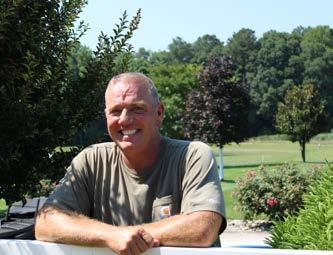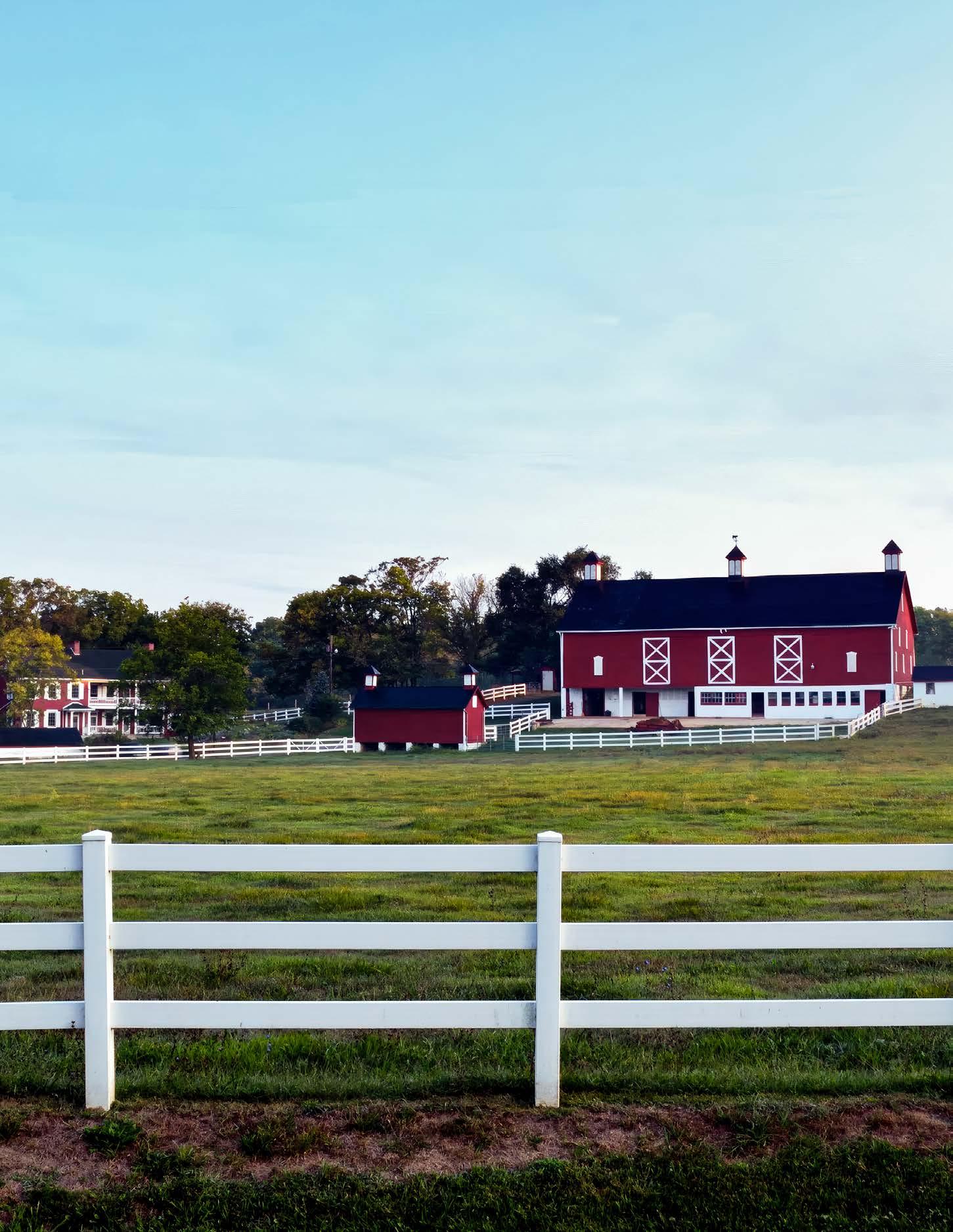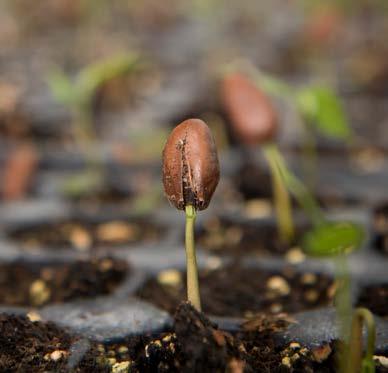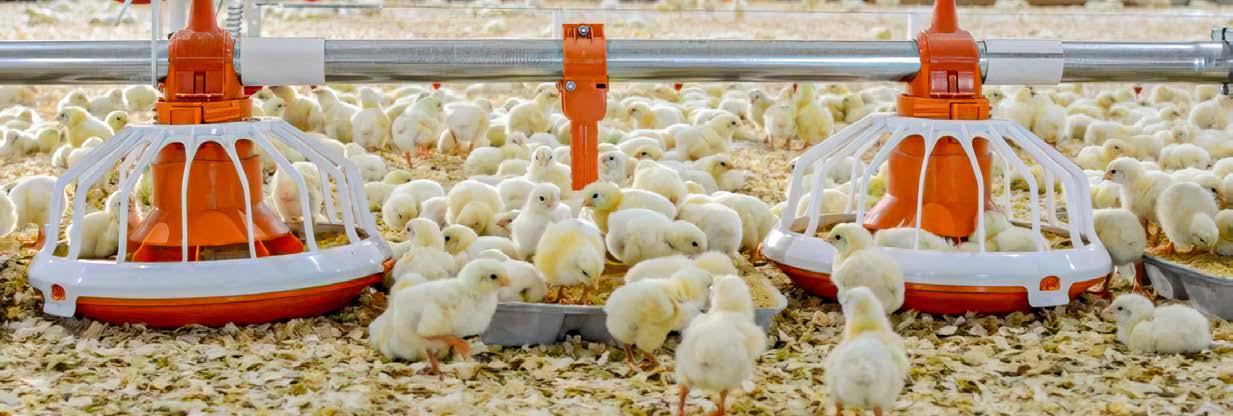LEADER
Conservation
THE ROLE OF IN AGRICULTURE
Three farmers share the importance of conservation and environmental stewardship to their operations.


Three farmers share the importance of conservation and environmental stewardship to their operations.

Horizon Farm Credit, ACA


Thomas H. Truitt, Jr., CEO
4 Octoraro Nursery: Raising “Mission-Driven” Plants for More Than 30 Years


6 PG Farms: Giving Back To The Land

8 Green Horizons: Turf

Board of Directors
Shawn D. Wolfinger, Chair
David R. Smith, Vice Chair
Paul D. Baumgardner
Julie Bolyard
Samuel BowerCraft
Brian L. Boyd
Kevin D. Grim
John Travis Hastings
Laura M. Heilinger
Anthony M. Ill
William K. Jackson
T. Jeffery Jennings
Sharon McClellan
Carl Metzgar
Fred R. Moore, Jr.
Michael S. Nelson
Sam Parker
Jennifer L. Rhodes
Paul H. Schmidt
Larry A. Seibert
Richard D. Shuman
Charles F. Ulmer
Christine Waddell
Charles M. Wright IV
If you have any questions or ideas for the editorial staff of the Leader, contact JoAnna Cameron at 888.339.3334, email her at jcameron@horizonfc.com or write her at Horizon Farm Credit | 300 Winding Creek Blvd | Mechanicsburg, PA 17050. This publication is for you, our reader. We’d love to hear from you!
The Leader is published semi-annually for stockholders, friends and business associates. If you wish to no longer receive this publication, please email: jcameron@horizonfc.com. Use “Unsubscribe Leader” in the subject line.
The Farm Credit Administration does not require the association to distribute its quarterly financial reports to shareholders. However, copies of its complete report are available upon request or see quarterly updates online at horizonfc.com
The shareholders’ investment in the association is materially affected by the financial condition and results of operations of AgFirst Farm Credit Bank and copies of its quarterly financial report are available upon request by writing:
Susanne Caughman
AgFirst Farm Credit Bank | P.O. Box 1499 | Columbia, SC 29202-1499
Address changes, questions or requests for the association’s quarterly financial report should be directed to Horizon Farm Credit, ACA by calling 888.339.3334 or writing:
Horizon Farm Credit | 300 Winding Creek Blvd | Mechanicsburg, PA 17050

As we welcome the color and cooler temperatures of fall, I’m struck by how much was accomplished over the summer, on farms across our footprint. While the days flew by, I know each was packed with productivity—because that’s what the ag community does.

I’m always inspired by the way farm families pour their time, talents, and treasure into their land, animals, and products. All aspects of production are carefully considered-from plant and animal genetics, to feeding programs, and vet care, from infrastructure and equipment, to soil health and environmental impacts.
Our producers are doing great things, every day, in these areas and from my experience, most will humbly dismiss their efforts as “just doing the right thing.” The bottom line is, farmers of all types are thoughtfully investing in practices and products that contribute to the quality of our soil, air, and water. It doesn’t stop there; these considerations often drive decision-making on the farm. Those who work the land, on parcels large and small, have a dedication to it that is truly unmatched. Ag producers are leaders in conservation and environmental stewardship, and they have a tremendous opportunity to make a positive impact.
I hope you recognize the value of your efforts. They are truly remarkable. We’ve featured three operations in this issue, but we’re proud of the outstanding and important work being done by so many of you across our footprint. Because of your thoughtful practices, we have a great story to tell about our industry’s commitment to conservation. We’re doing the right things, for the right reasons. Keep up the great work! We’re here to support you and your endeavors.
Tom Truitt Chief Executive OfficerLancaster County, PA
Producers involved in agriculture intrinsically “recognize that the soil is part of their livelihood and herd health is part of their livelihood,” Jim says. So when it comes to native plants and using them to help steward water resources, “I think that people who have that broad perspective of how conservation improves crops, herds, and the environment for their kids and the next generation — I don’t think it’s a hard sell,” says Jim. “Those people understand it, they get it,” and with increased media attention on conservation practices already being implemented in agriculture, shedding light on what is being done, those farmers are “finally getting some well-deserved recognition.”
Jim’s nursery, which sells wetland-specific native trees and shrubs to government, private sector, and non-profit clients along the mid-Atlantic seaboard, is largely focused on growing a collection of native shrubs and trees that will tolerate moderately wet to wet environments along streams.

“Our plants have to work for their dinner,” says Jim. “They are out there to provide ecological services. They are there to clean our air, clean our water, sequester carbon - they are like mission-driven plants.”
“We are not looking for planting photo ops,” he says. “We are looking for, at the end, a forest at the edge of a stream. A variety of trees such as maple, sycamores, oaks, and gums and river birch add height, plus shorter plants provide midcanopy and shrub layers," according to Jim. “It’s a palette of plants,” he says, “that you’re looking to establish a forested buffer along a stream.”
The native-plant nursery business has changed a lot over the years, he says.
“In the early years our sales were regulatory driven; it was mostly for mitigation where
THAN 30 YEARS
“In general, when I read about what I’ll call the other parts of agriculture — food and fodder and animal — I think conservation ethics are mostly inherent in ag,” says Jim MacKenzie, managing partner of Octoraro Native Plant Nursery Inc. in Kirkwood, Pennsylvania.
developers were required to mitigate their impact, DOT work and developers that were going into wetlands. We dealt with a few nonprofits, but over the years that has expanded dramatically, so now we deal with almost any level of government or the entities that they fund through grants or contracts,” he says. The business also supplies landscapers that specialize in restoration or environmental-type planting and non-profit sectors such as the Chesapeake Bay Foundation plus other watershed organizations and water-quality projects.
Additionally, “a lot of our plants are going on farms as part of the Conservation Reserve Enhancement Program (CREP), or Environmental Quality Incentives Program (EQUIP) — basically anything that’s bringing water quality to the farms,” says Jim.



“We sell to golf courses, academic institutions; private landowners, master watershed stewards, and master gardeners,” according to Jim. Also, today “homeowners are seeking out native plants more than ever before,” he says.
Nursery operators are also farmers, he points out. “Nurseries are part of ag, recognized by federal, state, local government as part of ag, so by the very nature of our business by growing crops we are part agriculture,” Jim says. “We practice conservation on both of our properties and then we supply the plants and products to the ag community that does the same thing on their farms.”
Jim “grew up playing in streams,” he remembers. “From first grade on, every day after school I was in the steams,” which was the beginning of his interest in water quality and conservation. At Penn State, as he studied landscape architecture, “I gravitated to professors that focused on stewardship and environmental issues,” he says.
In 1994, Jim began partnering with Mark Gutshall, who founded the Octoraro Native Plant Nursery in 1990, which allowed Jim to explore the environmental side of landscaping. Jim’s knowledge base expanded even more through organizations such as the Pennsylvania Landscape and Nursery Association, plus other associations where he “got exposed to other growers,” he says. “They were great sounding boards and I learned a lot about the industry in general — however what we were growing at the time was unique. I could get general information but we were also writing our own playbook.”
Because native plants were “still an emerging market” at that time, Jim recalls finding that traditional banks “weren’t willing to go as far as we needed to,” and that’s when Farm Credit stepped in. “They understood our industry,” he says. “Now, I refer anybody I can to Farm Credit because we’ve just had a great experience. We’ll never go anywhere else.”
Currently, Octoraro Native Plant Nursery has put together a team that has propagating their plants down to a science. “We’re propagating seeds for our own plants,” he says, adding that “taking a seed to a saleable plant is quite an involved process and is different for every single species. So that is a challenge, but it’s also the fun part,” he says, noting that his team often collects seeds from mature trees already on the property in an established wetland area. The seeds go through a forced dormancy before they move on through the propagation and growth process.

The nursery has expanded its size, products, market, and expertise significantly over the last three decades. Their business has been built on a firm commitment to conservation and the plants they grow extend environmental benefits everywhere they’re planted. Octoraro Native Plant Nursery’s “mission-driven plants” are making a tremendous impact across the region.
Visit their website: octoraro.com.
“I think that people who have that broad perspective of how conservation improves crops, herds, and the environment for their kids and the next generation — I don’t think it’s a hard sell.”
— Jim MacKenzie
Dan Parsons, owner and operator of PG Farms, strives for excellence in all he does. He’s been an entrepreneur for thirty years. Dan runs a successful commercial landscaping business and maintains his real estate license. Seven years ago, he added the title of poultry farmer to his growing list of accomplishments.
The urge to start a farm came from his drive to have more diversification.
“Nobody in the family had ever done it,” Dan explains. “It was scary when they dropped off 200,000 chickens.”
But Dan accepted the challenge, and has seen exceptional growth. His wife, Marla, was previously a registered nurse, but now runs their office operations. They have two grown children, and their eldest works for his business as well.
Farm Credit was able to help Dan refinance when the timing was right. “I’ve absolutely been pleased with them,” he says.
Since its inception, a key element to his farm has been the approach of giving back to the land. He owns a couple hundred acres that has been bought over time. With growth comes change, and Dan is mindful of how it effects the environment around them.
“When you put a poultry farm in the middle of all this, you’re changing nature,” Dan shares. “And that’s why you have to give back some.”
His conservation efforts started with solar panels; 468 to be exact. The entire farm is run by solar, including his home. He’s very pleased that he invested upfront and the visual impact is minimal. Another aspect of Dan’s approach to conscientious management is stabilization of the land.

When you pull up to PG Farms in Salisbury, Maryland, you’re greeted by a well-manicured panorama. A pristine pond sets before a woodland backdrop, while solar panels glisten off to the side. As your eyes travel throughout the land, perfectly appointed chicken houses line up across the way. Every detail has been thoughtfully considered, and it shows.
Dan built a berm alongside the chicken houses to lock in the landscape. Tree buffers and switchgrass have been planted along the roadside to establish natural hedges. Dan likes to use them to support wildlife, catch discharge, and to be friendly to his neighbors. Grass clippings are always monitored, clover is abundant, and annual rye shades the ground. He runs test areas in his fields to see how the ground handles the cover crops, and to keep weeds at a minimum. A newly built addition is the pond system, which includes a small forebay pond to capture sediment before entering the large two acre stormwater pond.
“Everything flows through stabilized turf,” he says.
With so much emphasis being placed on securing the ground at PG Farms, Dan knows that it doesn’t stop there. In order to support nature, all of its elements must be considered and respected. And that includes its wildlife.
Dan states, “We’re impacting them any time we do anything, so we try to limit and give back a little bit.”
He’s watching out for deer by creating these landscape buffers, wanting to protect them from the road. He tends to stray cats, and even builds resting spots throughout the farm for them to call home. Some have become pets, and live inside with he and his wife. His concern for animals doesn’t stop with the wildlife or the adopted cats; the care he provides to his chickens is commendable.
“If you watch them, they’re happy,” he says about his flock. “You've got to know what you’re listening for. They’ll tell you if they’re hot or cold. And you just make adjustments accordingly.”
Dan likes to use wood shavings for his compost because it’s environmentally friendly. The wood shavings are a carbon source to generate heat that gets added back into the chicken houses.
Additionally, he adds clean wood shavings to the litter in the poultry houses, which helps with the windrowing process.


You would never know that Dan has been a poultry farmer for only seven years. The knowledge he’s obtained is impressive and his application of that knowledge is evident, across the farm. He sells his poultry to Perdue, and gives them credit for talking him through some of the initial logistics. But so much has been accomplished because of Dan’s shear willpower to learn and grow. He’s done the research and continues to educate himself.
The thoughtfulness behind PG Farms is palpable, and Dan’s conservation efforts lead the way.

“When you put a poultry farm in the middle of all this, you’re changing nature. And that’s why you have to give back some.”
— Dan Parsons
J Ware III, of Green Horizons Turf Farms in Kearneysville, West Virginia, didn’t start out farming the way he is today. “I’ve had my trial and errors, trying to figure things out,” shares J. “My father was very encouraging to my ideas. He allowed me to do many things on my own and learn from gaining experience.” J is the seventh generation to farm in Jefferson County, West Virginia. He is proud to carry on his family’s farming history that spans over 200 years.

J began turf farming on a small lot on the family farm. He came home with an agricultural business degree from West Virginia University, where he focused his final semester on turf management. The 400 acres of farmland has long produced cattle and crops; it now utilizes 160 of those acres for turf which is sold to Green Horizons’ commercial, residential, sports and golf customers. So far, sod delivery spans to the states of Ohio, Pennsylvania, Maryland, New York, Virginia, and West Virginia.
“We offer different types of sod products,” he explains. “Our cool-season turf grasses range from fescue to improved varies of bluegrass.” Green Horizons offers sod delivery, installation and hydroseeding to their customers. “The Shenandoah Valley has some of the best soils and climate for turf farming,” shares J. “We do have our share of rocks and drought-like conditions at times.” From seeding to harvest, it takes about one year to 18 months before the turf is viable for harvest. “We are constantly managing the grasses for disease, insects, dry weather (irrigation), and mowing,” he says. “The area needs to be very smooth and free of stones so the root system can be well-established.”
Sod farming comes with a strong, upfront investment. Investments such as these come with risk, so they reached out to Farm Credit. “Jeanie Hamilton was our loan officer at the time, and still helps with our investment,”
To do a job with great care and such attention to detail, one must be conscientious of all things involved in an operation. It takes time and a lot of trial to overcome the challenges on a turf farm.
he shares. “We decided to go with Farm Credit because of the way they understand agriculture and how business works during seasons. A typical bank doesn’t get why we have a lot of upfront investment or understand the cashflow process of a farm.” J says that Jeanie has been exceptionally helpful from beginning and stops in to see what may be needed, or to just say hello.
The diversity seen on J’s family farm is a great asset, to both their business and their conservation efforts — but not everyone understands turf farming initially. “It doesn’t matter if you come from an ag background or not, you have to be able to educate people on what you are doing, and your goals,” he comments. “I have to be vocal about what is considered agriculture at times. Typical agriculture can sometimes fit into a stereotype, and we are able to help ourselves by offering information about products and conservation.”
Green Horizons Turf Farm was named the 2022 West Virginia Conservation Farm of the Year for their, “ability to control erosion and build organic matter in their soil,” as noted by the West Virginia Conservation Agency. “A stereotype of sod farming is that it strips topsoil and adds to the overall carbon footprint,” J states. “By use of state-of-the-art equipment and land management practices, we are able to leave vital topsoil, allowing grasses to grow until it’s mature root system has been developed. Once the sod is harvested, cover crops are planted.” They cover with soybeans, black oats, and depending on the time of year, forages for his father’s cattle. Cover crops maintain soil structure, control erosion, and replenish soil nutrients. An irrigation system is used on the grass to control water output and sustain the health of the soil, and levels can be
maintained through technology. Precision soil sampling is observed on their sod fields, too.
J and his wife, Andrea, run the business while raising their two children, August and Edy. J met Andrea at a concert when she was working in Washington D.C. Originally from Kansas, Andrea worked in broadcast media for 12 years and admired his agricultural background and AGR affiliation from college. The two hit it off, were married, and work together fulltime on the family farm.
They enjoy raising their children, teaching them about the farm, how to use equipment, and participating in their beef projects at the fair.
“It’s hard to tell what the kids will be involved
in, they’re still so young,” explains J. “August (10) is already business minded, coming into his second year of growing pumpkins, he’s increased his patch to an acre in size. Edy (5), well, she’s going to conquer anything she puts her mind to!”
It’s clear that Green Horizons Turf Farm is a beautiful place to raise a family. It’s also a shining example of how ag diversity, innovation, and conservation practices can drive business value and keep a multi-generational farm thriving.

 Visit Green Horizons Turf Farm at greenhorizonsturf.com.
Visit Green Horizons Turf Farm at greenhorizonsturf.com.

“I have to be vocal about what is considered agriculture at times. Typical agriculture can sometimes fit into a stereotype, and we are able to help ourselves by offering information about products and conservation.”
— J Ware III
You rise to the occasion every day with your farm or ag business. Keep reaching with Farm Credit’s Farmers on the Rise Award of $10,000.

If you are a beginning farmer with 3 to 10 years of farming experience, you could be eligible to grow your business through our award program.
Applications are open from August 25 through October 6, 2023 at 4:00pm. Scan the QR code or visit horizonfc.com/rise to learn more.
The Farm Credit Foundation for Agricultural Advancement is awarding $10,000 scholarships to students studying to pursue a career in ag. This doesn’t just mean you’re planning to farm — you may be planning to become a food scientist, ag educator, or even a Farm Credit employee. The possibilities are endless!


This scholarship program is open to:
• High school seniors
• Trade and technical school students
• Currently enrolled undergraduate/graduate students in a twoor four-year program
Applicants must reside within Horizon Farm Credit’s 100 county footprint or Washington, D.C.
Applications are available online and will be accepted September 22, 2023 through January 5, 2024.
Visit FCFoundationForAg.org or scan the QR code for more information!
Questions can be directed to info@fcfoundationforag.org
We received a record number of submissions this year and will feature many of them, beyond those selected for the calendar, in print ads, social media, and digital platforms. Thank you to everyone who shared their photos!

Those named below will have their photos included in our 2024 calendar!
Allison Beichner
Chelsea Blickenstaff
Sarah Cotton
Kelcie Degenfelder
Brenda Deibel
Jessica Engle
Mitchell Freeman
Aspen Gair
Kasey Kreit
Julia Martin
Debra Morgan
Deborah Phillips
Riley Price
Brenda Ripley
Laura Russum
Sawyer Sheubrooks
Lily Sollenberger
Ashlyn Stafford
Hallie Steck
Angie Vann
Michael Williams
Cody Windisch
Susan Younker